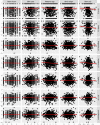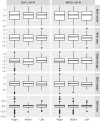A deep phenotyping approach to assess the association of handedness, early life factors and mental health
- PMID: 37714904
- PMCID: PMC10504248
- DOI: 10.1038/s41598-023-42563-7
A deep phenotyping approach to assess the association of handedness, early life factors and mental health
Abstract
The development of handedness and other form of functional asymmetries is not yet understood in its critical determinants. Early life factors (e.g., birth weight, birth order) have been discussed to contribute to individual manifestations of functional asymmetries. However, large-scale data such as the UK Biobank suggest that the variance in handedness that is explained by early life factors is minimal. Additionally, atypical handedness has been linked to clinical outcomes such as neurodevelopmental and psychiatric disorders. Against the background of this triad, the current study investigated associations between different forms of functional asymmetries and (a) early life factors as well as (b) clinical outcomes. Functional asymmetries were determined by means of a deep phenotyping approach which notably extends previous work. In our final sample of N = 598 healthy participants, the different variables were tested for associations by means of linear regression models and group comparisons (i.e., ANOVAs and Chi-squared tests). Confirming previous findings from larger cohorts with shallow phenotyping, we found that birth factors do not explain a substantial amount of variance in functional asymmetries. Likewise, functional asymmetries did not seem to have comprehensive predictive power concerning clinical outcomes in our healthy participants. Future studies may further investigate postulated relations in healthy and clinical samples while acknowledging deep phenotyping of laterality.
© 2023. Springer Nature Limited.
Conflict of interest statement
The authors declare no competing interests.
Figures





Similar articles
-
Stress exposure, hand preference, and hand skill: A deep phenotyping approach.Laterality. 2023 Mar-May;28(2-3):209-237. doi: 10.1080/1357650X.2023.2204551. Epub 2023 Apr 26. Laterality. 2023. PMID: 37099727
-
Polygenic scores for handedness and their association with asymmetries in brain structure.Brain Struct Funct. 2022 Mar;227(2):515-527. doi: 10.1007/s00429-021-02335-3. Epub 2021 Jul 8. Brain Struct Funct. 2022. PMID: 34235564 Free PMC article.
-
Voxel-wise grey matter asymmetry analysis in left- and right-handers.Neurosci Lett. 2016 Oct 28;633:210-214. doi: 10.1016/j.neulet.2016.09.046. Epub 2016 Sep 26. Neurosci Lett. 2016. PMID: 27687715
-
Atypical lateralization in neurodevelopmental and psychiatric disorders: What is the role of stress?Cortex. 2020 Apr;125:215-232. doi: 10.1016/j.cortex.2019.12.019. Epub 2020 Jan 16. Cortex. 2020. PMID: 32035318 Review.
-
Beyond the genome-Towards an epigenetic understanding of handedness ontogenesis.Prog Neurobiol. 2017 Dec;159:69-89. doi: 10.1016/j.pneurobio.2017.10.005. Epub 2017 Oct 31. Prog Neurobiol. 2017. PMID: 29100839 Review.
Cited by
-
Using the online version of the Trier Social Stress Test to investigate the effect of acute stress on functional lateralization.Sci Rep. 2024 Sep 6;14(1):20826. doi: 10.1038/s41598-024-71668-w. Sci Rep. 2024. PMID: 39242764 Free PMC article.
-
Handedness in schizophrenia and affective disorders: a large-scale cross-disorder study.Eur Arch Psychiatry Clin Neurosci. 2025 Apr;275(3):767-783. doi: 10.1007/s00406-024-01833-9. Epub 2024 Jun 25. Eur Arch Psychiatry Clin Neurosci. 2025. PMID: 38914850 Free PMC article.
References
-
- Güntürkün O, Ströckens F, Ocklenburg S. Brain lateralization: A comparative perspective. Physiol. Rev. 2020;100:1019–1063. - PubMed
Publication types
MeSH terms
LinkOut - more resources
Full Text Sources
Medical

